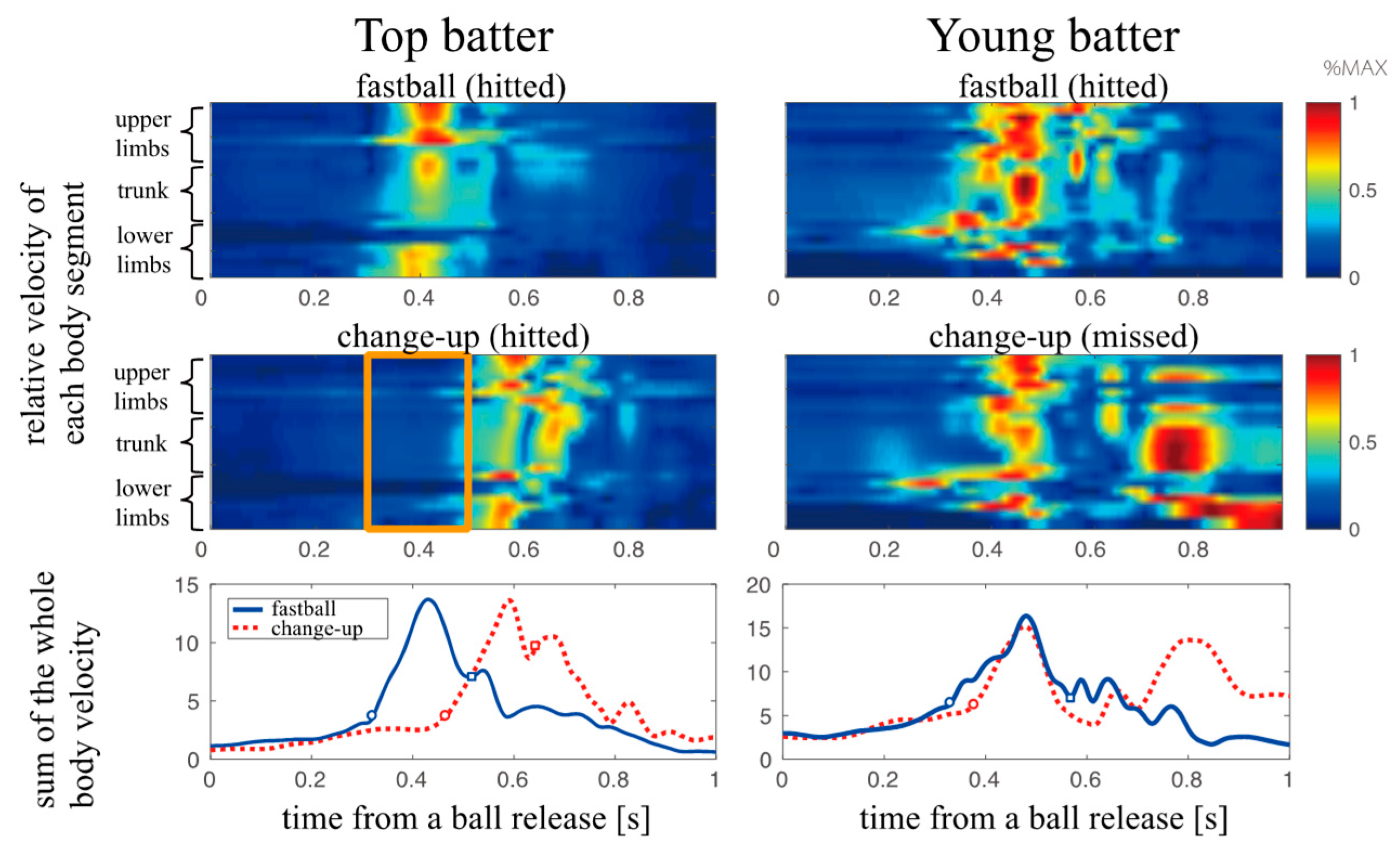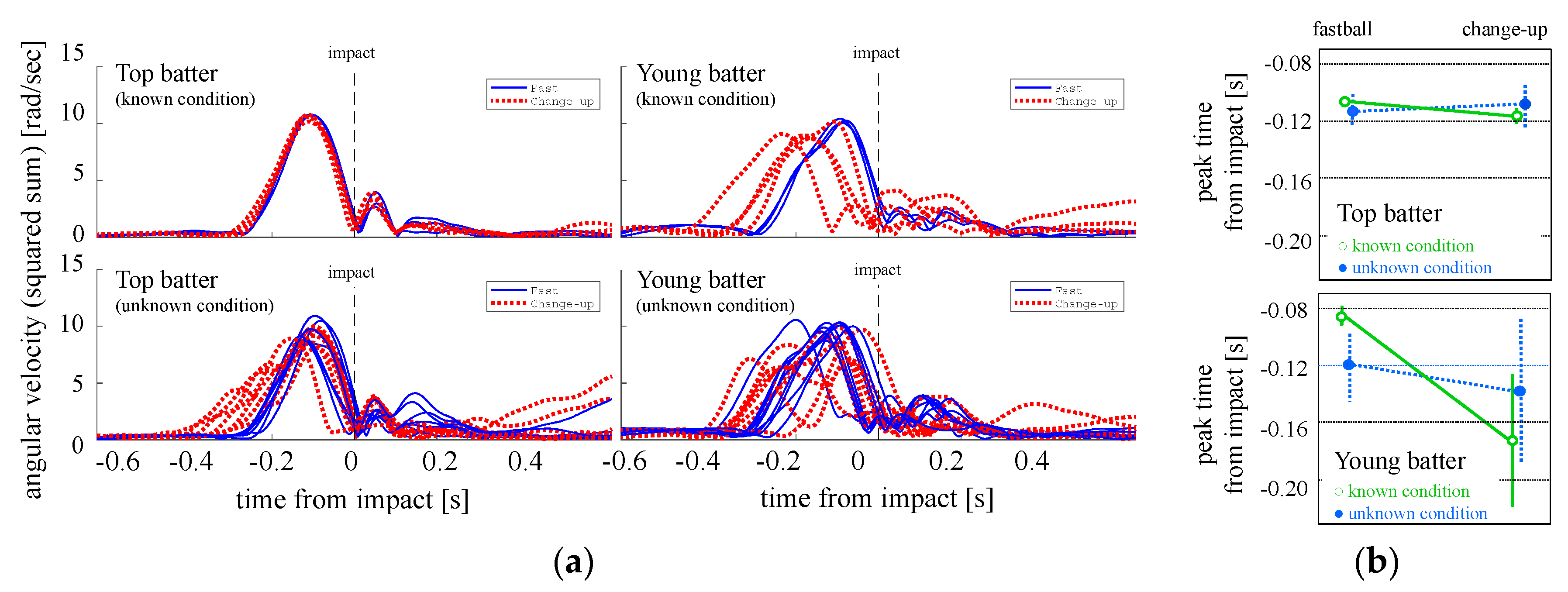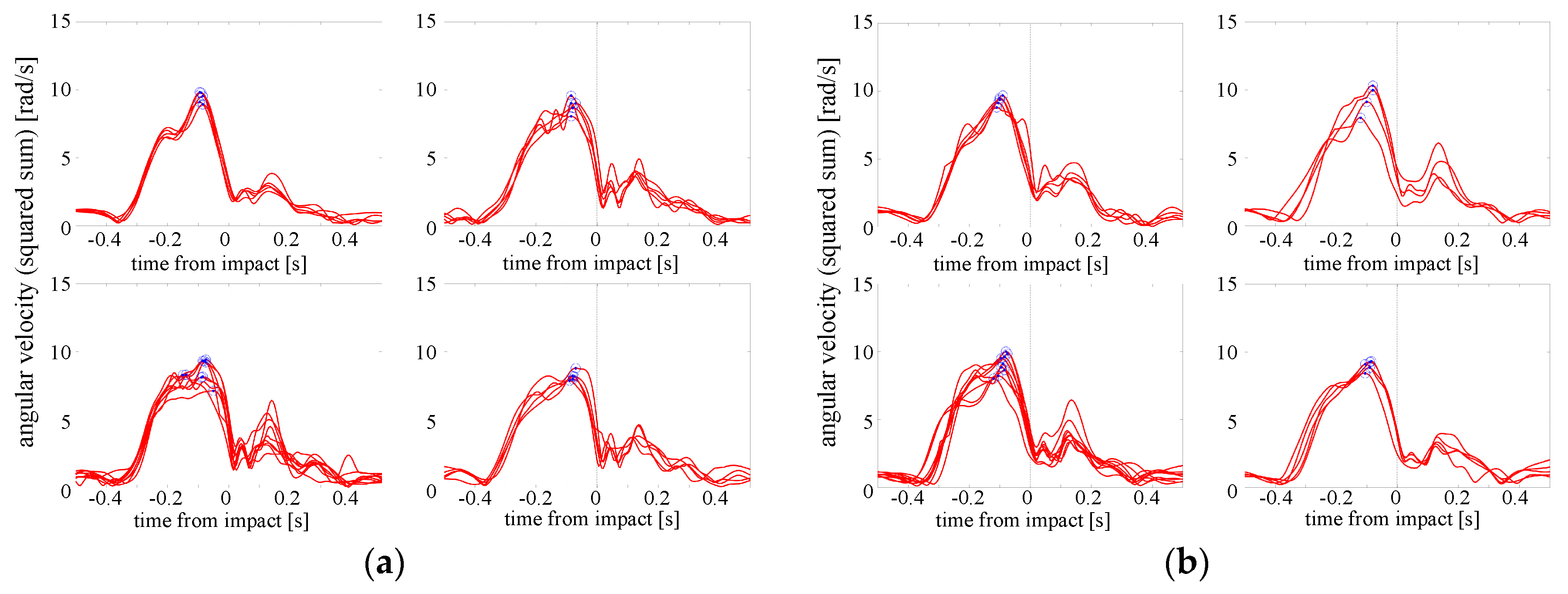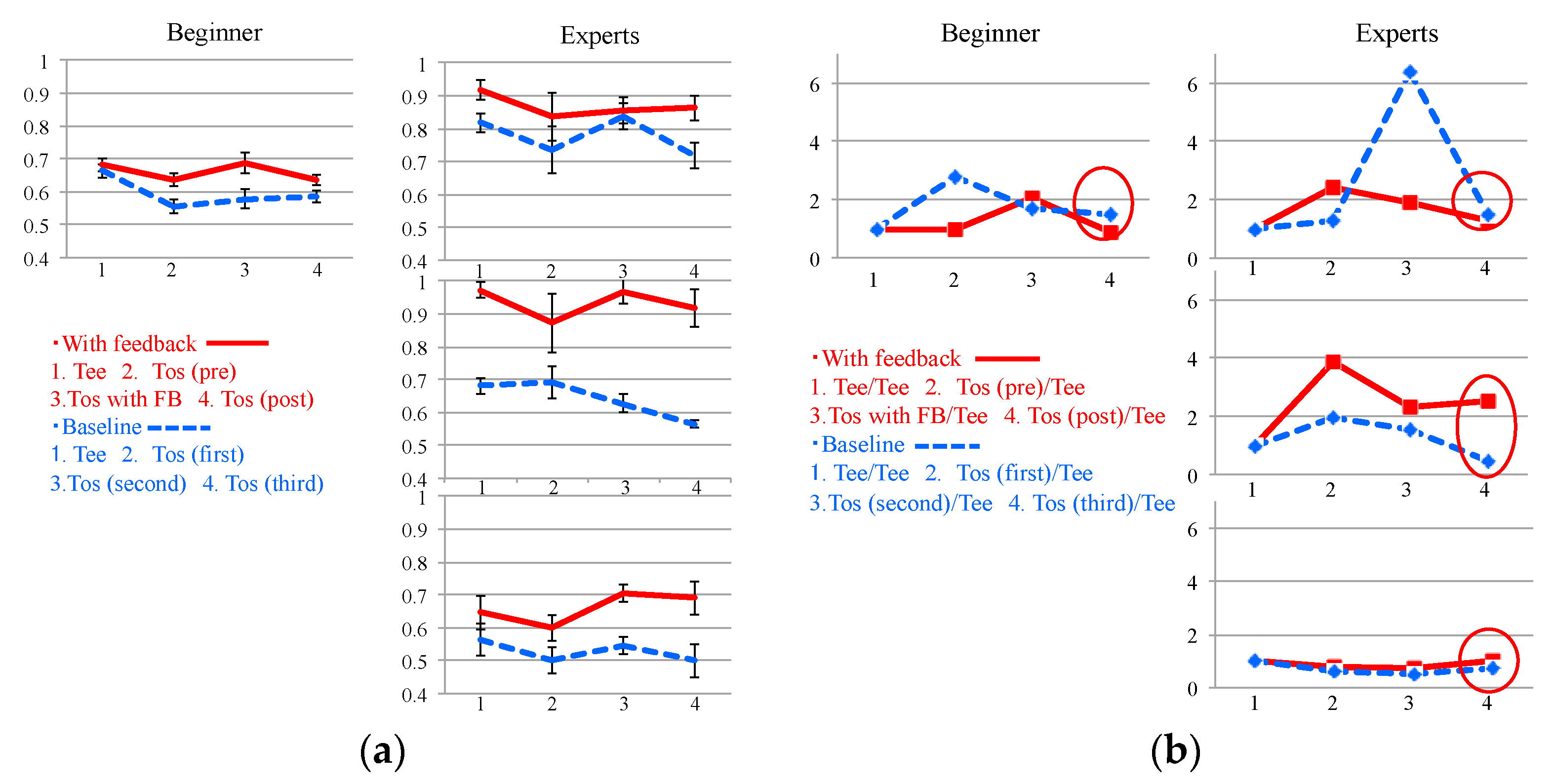1. Introduction
Skillful sports actions such as baseball batting, softball batting and golf shots depend on temporal coordination of body segments in extremely short periods. To develop a skillful batting technique for baseball and softball demands compound movements that can respond to deliveries with various speeds and trajectories. In order to produce high bat speeds and power, it is necessary for the body segments to accelerate at the proper timing [
1].
It is essential to understand the temporal patterns of one’s own movements if we are to improve our sports skill. Complicated sensing systems may have high accuracy and full body coverage but they preclude daily practice that is essential to develop dependable skills. For daily use, a simple measuring system is useful.
However, developing a feedback system for quick movement patterns is not easy. It is important to consider what kind of modality should be used for feedback of the motion. Visual feedback has insufficient temporal resolution and can be distracting. Auditory feedback is the more attractive candidate because auditory perception has high temporal resolution [
2]. For cycling, auditory feedback was used to visualize motion [
3]. We considered that auditory feedback can reflect time structure well and focused on auditory feedback.
The purpose of this study is to develop a batting motion system that can easily assess and improve the fundamental body movements by extracting and sonifying the fundamental metrics of whole body motion pattern.
2. Materials and Methods
2.1. Detecting Essential Features of Batting
In baseball and softball, a good batter adjusts his/her body motion to the wide range of ball speeds and trajectories expected. Our previous experiment with elite female softball players, some of whom had been on the national team, evaluated the movement features that occur during batting as regards two types of pitching (fastball and change-up), with different ball speeds (approximately 90 and 75 km/h, respectively) [
4]. The participants were asked to hit randomly pitched fastballs and change-ups. For each of the first three fastballs and three change-ups, the batters were informed of the type of pitch that would be thrown (known condition), and thereafter they were not informed (unknown condition). The whole body movements of both the batter and pitcher were recorded simultaneously by a motion capture system (240 Hz, MVN BIOMECH Link, Xsense Inc, Enschede, The Netherlands). All procedures used in this research were approved by the research ethics committee of NTT Communication Science Laboratories. It was shown that superior batters could adjust the timing of their swing motion to the ball impact according to pitch type with a high degree of accuracy. With a change-up, they paused their swing motion by about 300 ms after the ball was released and then continued their swing, which was not the case with young batters as shown as
Figure 1.
2.2. Sonifying Detected Features of Batting
2.2.1. System
Since we found that trunk rotation timing was critical for matching swing to pitch type, we constructed an auditory feedback prototype system that sonified the temporal patterns of batting movement gathered by two compact wireless nine-axes inertial sensors (LP-WSD1101-0A). The system was constructed around two inertial sensors and a receiver connected to a PC, which extracted the data of three-axis acceleration, three-axis angular velocity, and three-axis terrestrial magnetism and synthesized sounds as shown in
Figure 4a. Sampling rate of the two sensors was 200 Hz. One inertial sensor was fixed to a belt so that it was centered over the pelvis of the batter to detect the rotational patterns. The time taken for the squared sum of angular velocity components to peak was calculated; it indicates when the angular velocity was the maximum value. The other sensor was attached to the grip end of the bat by a rubber mount to detect the time of impact; the point at which the squared sum of acceleration is maximum. After each swing, the system converted the calculated peak time and impact time into two synthesized sounds, each was a single sine wave (frequency = 1200 Hz, length = 0.03 s, sampling rate = 44,100 Hz).
2.2.2. Sonification Experiment
We conducted a pilot sonification experiment to verify whether this feedback approach would be useful for batting practice. As the first step, we presented two sounds and verified whether the participants can pace of the rotational motion in batting. Three expert batters (32.3 ± 10.5 years-old) and one beginner person (22 years-old) participated. The participants were all male and right-handed. In addition, to examine the applicability to beginners, the same experiment was conducted with one expert man using the non-dominant hand and one female beginner.
The experiment was conducted on two days. We conducted a baseline experiment on day one and a feedback experiment on day two. In the baseline experiment, after practice, participants were asked to hit 5 tee balls, 5 toss balls, 10 toss balls, and 5 toss balls in order.
Figure 4b shows a picture of tee batting. In the feedback experiment, after practice, participants were asked to hit 5 tee balls, 5 toss balls, 10 toss balls with auditory feedback and 5 toss balls in order. At the beginning of toss batting with auditory feedback, two training sounds were presented in the same way as above and participants were asked to swing so as to reproduce the training sound as closely as possible and keep it constant during toss batting. The training sounds were presented at very short (0.11 s) intervals, from the result of top players’ batting (
Figure 3b). An aluminum softball bat, GNRS30216 (SSK), was used ( length: 0.83m, diameter: 57mm, mass: 700 g ). Tee height and location of the tee were chosen by each participant and toss pitches were generated by a toss-machine. Participants were asked to hit the ball as strongly as possible in all trials.
Prior to processing, all data were smoothed using a fourth-order, zero phase shift, low pass Butterworth filter with a cut-off frequency of 10 Hz. Data recording started 4 s before the swing, and data from 1 s before impact to 1 s after impact were analyzed. Incomplete data and data over mean ± 2sd were eliminated from the analysis.
3. Results
Figure 5a shows plots of the squared sum of angular velocity components in each phase of one expert participant in baseline experiment and
Figure 5b shows those in feedback experiment (b).
Figure 6a shows average values of peak time divided by teaching time (0.11 s) of each participant.
Figure 6b shows average values of variations in peak time of each participant. To normalize the variations in peak time, each variation in peak time in toss batting was divided by the variation in peak time in tee batting.
Table 1 shows average value and peak time variation, and peak amplitude of each participant at toss batting (second).
With regard to peak time, the average value of peak time tended to be long for the expert participants and close to the training value; there was no discernible trend in the variation.
4. Discussion
The results indicate that the current approach of generating two sounds at peak trunk rotation speed and at impact may make peak time more closely approach the training sound but may not provide much benefit in enhancing batting performance, especially in terms of decreasing the variation in timing. There are two possible reasons, one is that the variation in peak time is not large as it is in actual games. Compared to tee batting, when hitting a pitched ball, it is necessary to judge the course of the ball, which makes the time of swing motion shorter and the variation of time larger. And the other is the interval between peak and impact is too short to be useful. It is still unclear this feedback way can apply for actual batting, so we will conduct an experiment in actual batting in future.
Unlike professional athletes, as shown by
Table 1, participants demonstrated larger variation in amplitude than in time at peak trunk rotation speed in this experiment, especially the beginners.
Figure 7 shows trajectories of angular velocity in toss batting of the man beginner and woman beginner. Both exhibit large variation in amplitude. Thus it may be better to feedback the magnitude of the amplitude.
5. Conclusions
Our goal is to create a convenient self-monitoring system that can be used in daily practice for improving batting skill. To permit daily use, the data logging system must be extremely compact while adequately extracting whole body segment motion. Our previous experiments showed that top and young batters demonstrated different temporal sequences in whole body movement. Such characteristics were acquired by mounting a nine axis sensor at the pelvis. This study developed a sonification system so as to create feedback useful in batting practice. This experiment examined peak trunk rotation time.
As a result, this feedback approach could not suppress variations of peak time with toss batting, but may make peak time approach training sound. Also, unlike professional athletes, the variation of amplitude of trunk rotation is large, so it may be effective to convert the amplitude to sound. The significance of this study lies in its simple but powerful data logging system; one sensor on the bat and one at the pelvis. In the future, by combining this with a batting sensing system which measures batting performance, we believe that it is possible to make a more efficient batting improvement system.











